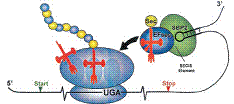Biochemistry, Department of

Vadim Gladyshev Publications
Document Type
Article
Date of this Version
January 2008
Abstract
Copper is an essential trace element in many organisms and is utilized in all domains of life. It is often used as a cofactor of redox proteins, but is also a toxic metal ion. Intracellular copper must be carefully handled to prevent the formation of reactive oxygen species which pose a threat to DNA, lipids, and proteins. In this work, we examined patterns of copper utilization in prokaryotes by analyzing the occurrence of copper transporters and copper-containing proteins. Many organisms, including those that lack copper-dependent proteins, had copper exporters, likely to protect against copper ions that inadvertently enter the cell. We found that copper use is widespread among prokaryotes, but also identified several phyla that lack cuproproteins. This is in contrast to the use of other trace elements, such as selenium, which shows more scattered and reduced usage, yet larger selenoproteomes. Copper transporters had different patterns of occurrence than cuproproteins, suggesting that the pathways of copper utilization and copper detoxification are independent of each other. We present evidence that organisms living in oxygen-rich environments utilize copper, whereas the majority of anaerobic organisms do not. In addition, among copper users, cuproproteomes of aerobic organisms were larger than those of anaerobic organisms. Prokaryotic cuproproteomes were small and dominated by a single protein, cytochrome c oxidase. The data are consistent with the idea that proteins evolved to utilize copper following the oxygenation of the Earth.


Comments
Published in PLoS ONE 3(1): e1378. Copyright © 2008 Ridge et al. Used by permission.